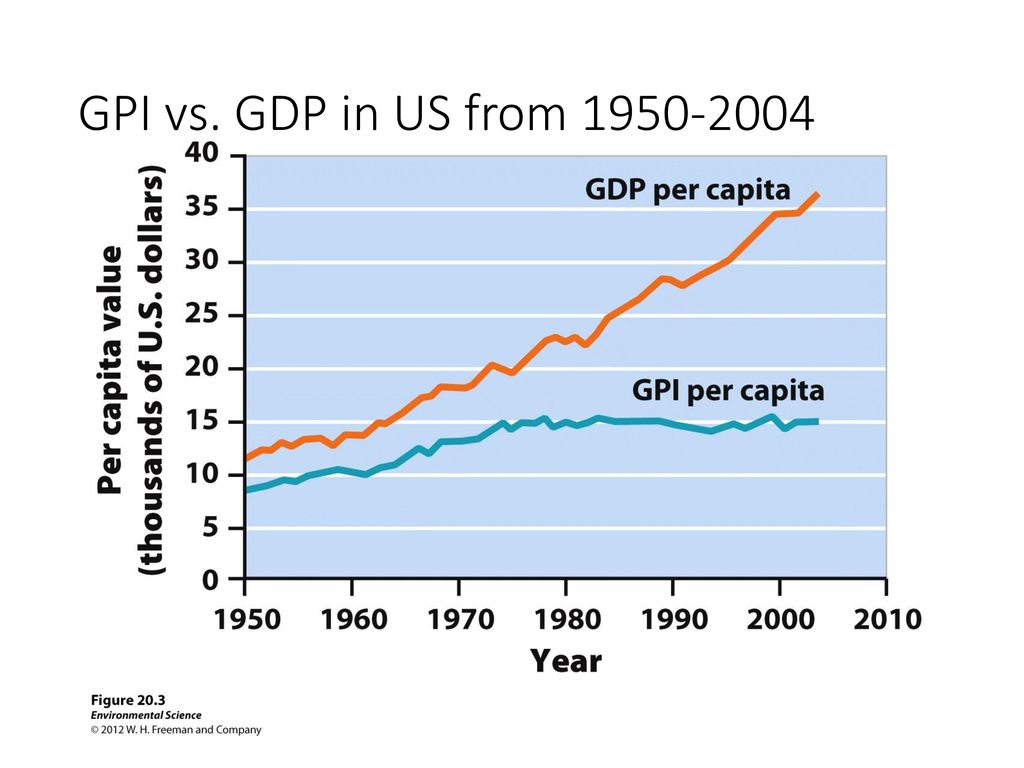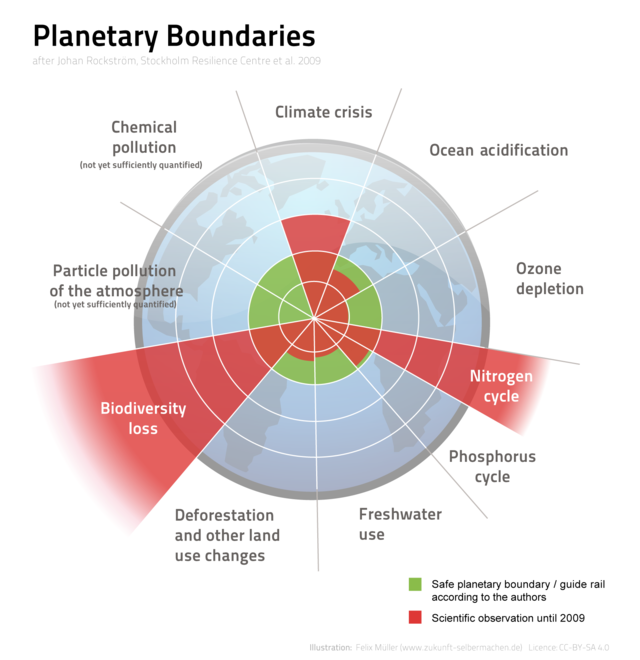The steady-state economy, the short version
Mainstream economies measure success through increases to GDP, which they call “economic growth.” This is based on the assumption that GDP is closely correlated with the well-being of society. But increasingly, we find that not only is GDP not as closely correlated to well-being as we imagined, but maximizing GDP has grave consequences for the environment and the sustainability of our society. The steady-state economy is a theoretical alternative that changes our definition of economic growth and moves us away from consuming more and more natural resources.
The steady-state economy, the longer version
We need economic growth and we need it bad! This has been a common refrain from both the left and right of the political spectrum for decades.
But is it really true? Can we achieve sustainable prosperity for all without actually “growing” the economy? Is an economy without growth even possible?
More and more people think so.
What is economic growth?
When people say we need to grow the economy, they are almost always talking about growing Gross Domestic Product, or GDP – that is, the total value of goods produced and services provided in a country.
As a country consumes more, GDP goes up. When it consumes less, GDP goes down.
Conventional wisdom says that as GDP goes up, we as a society are better off. This makes sense on some level – when poor families, communities, and nations produce and consume more, they are most likely eating more, using helpful technologies and services, and are generally able to better meet their immediate needs for survival and security.
But based on this fairly sensible notion, we’ve made growing GDP the most important goal of our economy. We’ve made it into a dogma. All the candidates in the 2016 U.S. election – even Bernie Sanders – called for economic growth and few people push back.
But is this the right goal to focus our attention on?
Is economic growth a good thing?
The problem is, there’s a lot of evidence that GDP doesn’t correlate particularly well with well-being. And if well-being isn’t our ultimate goal, what is?
Few doubt that increasing GDP per capita is helpful and necessary for the poor. For those without food and shelter, more resources and consumption is absolutely essential.
The question is: Do individuals – and economies – reach a point where more GDP per capita is no longer helpful? Once our basic needs are met, does higher GDP per capita really matter?
A 2013 study published in Ecological Economics suggests not. The study examined the connection between GDP and the Genuine Progress Indicator (GPI) across 17 countries between 1950 and 2003. It found that there is indeed a genuine connection between GDP and well-being until a certain threshold. After this, the correlation fades.

Image: W.H. Freeman and Company
This means that nations should indeed focus on building GDP as they come out of poverty. But once they are reasonably well off, other measures become more important and relevant.
For example, between 1972 and 2014 – a period of known economic growth – reported happiness in the United States was stable (General Social Survey). Our incomes grew, but they did not make us happier.
That makes sense, right? If you have $1000 to your name, having another $1000 will do wonders. But if you already have $100,000, an additional $10,000 is likely to have little impact on your true well-being. Moreover, if you have $200,000 but you get it from a soul-sucking job, you still probably won’t be happy per se.
So the notion that GDP growth and wealth accumulation should always be our core economic goal is tenuous – at best.
Unsustainable growth
But there’s a bigger problem.
Not only is there not much of a lasting correlation between GDP and well-being, growing our GDP actually hurts us and our planet.
The need for constant GDP growth fuels us to keep consuming, chewing up our finite natural resources and asking us to believe we will be happier if we buy more stuff. We already consume about 1.6 times more than what Earth can sustain (The Guardian).

The quest for constant economic growth pushes us to consume more, more, more. It insists that that new car or computer program or hand bag will finally make us happy. It asks us to consume more when we know we can and should consume less.
This is the definition of unsustainable. If Earth itself is not growing and it has finite resources, how can we expect to keep growing our consumption forever?
What would the world look like without economic growth?
So what’s the alternative? Can we really sustain an economy without growth? What would that even look like?
Some, such as Herman Daly and the Center for the Advancement of the Steady State Economy, are pointing to the steady-state economy as the solution.
Under the steady-state economy, we seek to stabilize GDP so that our economy functions within the limits of planetary boundaries. We hold the same level of consumption in perpetuity.
The economy is a function of our society. It exists to serve the good of society. And society is structured in a way that’s in harmony with the Earth.
This would allow us to use our natural resources sustainably. It would better balance existing wealth between the rich and the poor, so that everyone can have their basic needs met without increasing our total levels of consumption.
Note, the steady-state economy does not imply zero growth in well-being or prosperity. It doesn’t mean our happiness can’t grow. In theory, in the steady-state economy we would decouple our well-being from our consumption. Instead of growing GDP and material possessions, perhaps we’d be trying to grow time with our families, our health, sense of purpose, or our ability to pursue passions and interests.
The steady-state economy asks us to think of prosperity as a journey largely inside ourselves, not one found in our material possessions and external status.
The steady-state economy isn’t so much about getting rid of growth, but rather redefining what growth and progress mean. A no-growth economy really means a no-GDP-growth economy.
So how would this work exactly?
The steady-state economy is still theoretical. No one can say for sure how it’ll work or how to bring it about. That said, we do know a few things about it.
Under the steady-state economy, the goal is not to create as much money as possible. Rather, the goal is to ensure sustainable well-being for all. To achieve this, we would:
- Stabilize our population
- Minimize extraction of natural resources to within planetary boundaries
- Focus on labor-intensive, “inefficient” jobs (e.g., small-scale farming, artisans, artists, social workers)
- Ensure greater economic equality and restrain excessive consumption among the wealthy
- Curb banks’ ability to create money and loan it at interest, halting the debt cycle
- Reframe prosperity not as a function of material wealthy, but rather as an ability to have security, maintain healthy relationships, and pursue passion and purpose
But would this REALLY work?
There are, as you might expect, some compelling arguments against the steady-state economy. Some say we can decouple GDP growth from natural resource consumption, for example, through an information economy. Others say we can overcome our limits to growth by technological advancement and efficiencies.
I am not an economist or an engineer. These are indeed both possibilities. We may not need the steady-state economy after all.
However, whether or not we end up truly implementing the steady-state economy, the very idea of it is critical for us at this moment in time. It asks some fundamental questions that have gone unconsidered for too long:
Is the purpose of our economy to maximize the amount of money and things we all have? Or is the purpose of our economy to bring security and a sense of well-being to all in a sustainable fashion?
Will we move forward on the assumption that material wealth equates to prosperity? Or will we tell a new story: that prosperity is a much more profound, mysterious, and internal phenomenon than we’ve ever let ourselves believe?
The steady-state economy, in practice
The Centre for the Understanding of Sustainable Prosperity (CUSP) – founded by Tim Jackson, Professor of Sustainable Development at the University of Surrey and author of Prosperity Without Growth – is a research institution based in the UK that explores the economic, ecological, social and governance dimensions of sustainable prosperity. CUSP uses its research to offer solutions and concrete recommendations to government, business and civil society, and others driven by the core question: What can prosperity possibly mean in a world of environmental, social and economic limits?
Next steps
How can we as individuals help change the core assumptions and goals of our economy?
First and foremost, we can challenge our own conception of prosperity, success, and value. When we as individuals equate big houses, fancy cars, and endless new gadgets and toys as prosperity, our economy will match those assumptions. But when more of us begin to equate inner peace, a sense of purpose, quality time with friends and family, and other less tangible assets as “success”, then we can start a chain reactions in our communities and our economy.
And when anyone mindless asserts the need to grow our economy at all costs, you can simply ask: Grow what? The amount of money in the system? Or our actual prosperity? And are these really the same thing? Who is most served by maintaining that assumption?
Recommended reading
![]() Prosperity without Growth: Foundations for the Economy of Tomorrow
Prosperity without Growth: Foundations for the Economy of Tomorrow
by Tim Jackson
The publication of Prosperity without Growth was a landmark in the sustainability debate. Tim Jackson’s piercing challenge to conventional economics openly questioned the most highly prized goal of politicians and economists alike: the continued pursuit of exponential economic growth.
Further Reading
- Steady-State Economy – Wikipedia
- Finally, a breakthrough alternative to growth economics – the doughnut – by George Monbiot
- The nine planetary boundaries – by Stockholm Resilience Centre

